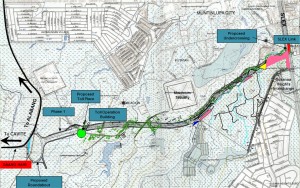The government’s proceeds from the Daang Hari link may be cut in half after it was revealed that the Department of Public Works and Highways approved a last-minute change in the project’s interconnection design without the consent of the operator of the South Luzon Expressway to which the tollway will connect.
Due to the snag, work on the 4-kilometer tollroad—won by the Ayala group with a P902-million bid—has yet to begin almost 11 months after the project was awarded, according to official documents obtained by the Inquirer.
More importantly, a source involved with the project said the new design proposal approved by the DPWH would cost anywhere between P250 million and P500 million—a so-called “variation order” that would have to be shouldered by the government. The variation order would reduce the government’s net proceeds from the Daang Hari project to as low as P400 million from the original winning bid of the Ayala group.
The source explained that instead of using the rotunda design that was bid out by the DPWH, the Ayala group submitted two construction plans, which the DPWH accepted shortly before the financial bids were opened late last year.
“The new design that DPWH accepted is very different from the one they originally approved,” the official said. “Instead of a roundabout, there will now be a bigger toll plaza, while the connection to [the northbound lanes of] SLEx will require a longer tunnel under it.”
The official explained that the Ayala proposal approved by DPWH was meant to connect to the existing SLEx design without taking into account the highway’s upcoming expansion, which would increase its number of lanes from eight to 10 to accommodate growing vehicular traffic volume—a provision built into the original concession of SLEx’s operator, South Luzon Tollways Corp. (SLTC).
SLTC is the concessionaire for the 36-kilometer expressway from Alabang, Muntinlupa City, to Sto. Tomas, Batangas, and is majority-owned by Atlantic Aurum, a partnership between Citra of Indonesia and San Miguel Corp.
Upon the request of the DPWH, SLTC earlier issued a “no objection” letter to the project on the condition that its future expansion plans would not be jeopardized. Upon learning of what it described as “material changes” made by DPWH, however, SLTC withdrew its consent and was now being blamed for the delay in the project.
The source explained that the Ayala group was now in a bind since DPWH has not informed bidders that SLTC’s consent was limited to the rotunda design. “But DPWH accepted Ayala’s design changes so DPWH also has to shoulder the variation costs of as much as P500 million,” the official said. “I don’t think Ayala will agree to shoulder it, and neither will SLTC.”
Last year, 18 bidders expressed interest in the Daang Hari PPP project, but only two entities—the Ayala and San Miguel groups—were pre-qualified by the government.
The official revealed that some disqualified bidders were now questioning the process adopted by the government because of two major changes made during tender process.
After the submission of the prequalification documents, DPWH raised the tariff for the project by 25 percent and lengthened the concession period from 25 to 30 years, issued through a bid bulletin, together with the revised draft concession agreement.
“But there were bidders who opted out of the project earlier because of the low tariff and short concession period and they didn’t know that these parameters were adjusted,” the official said.
